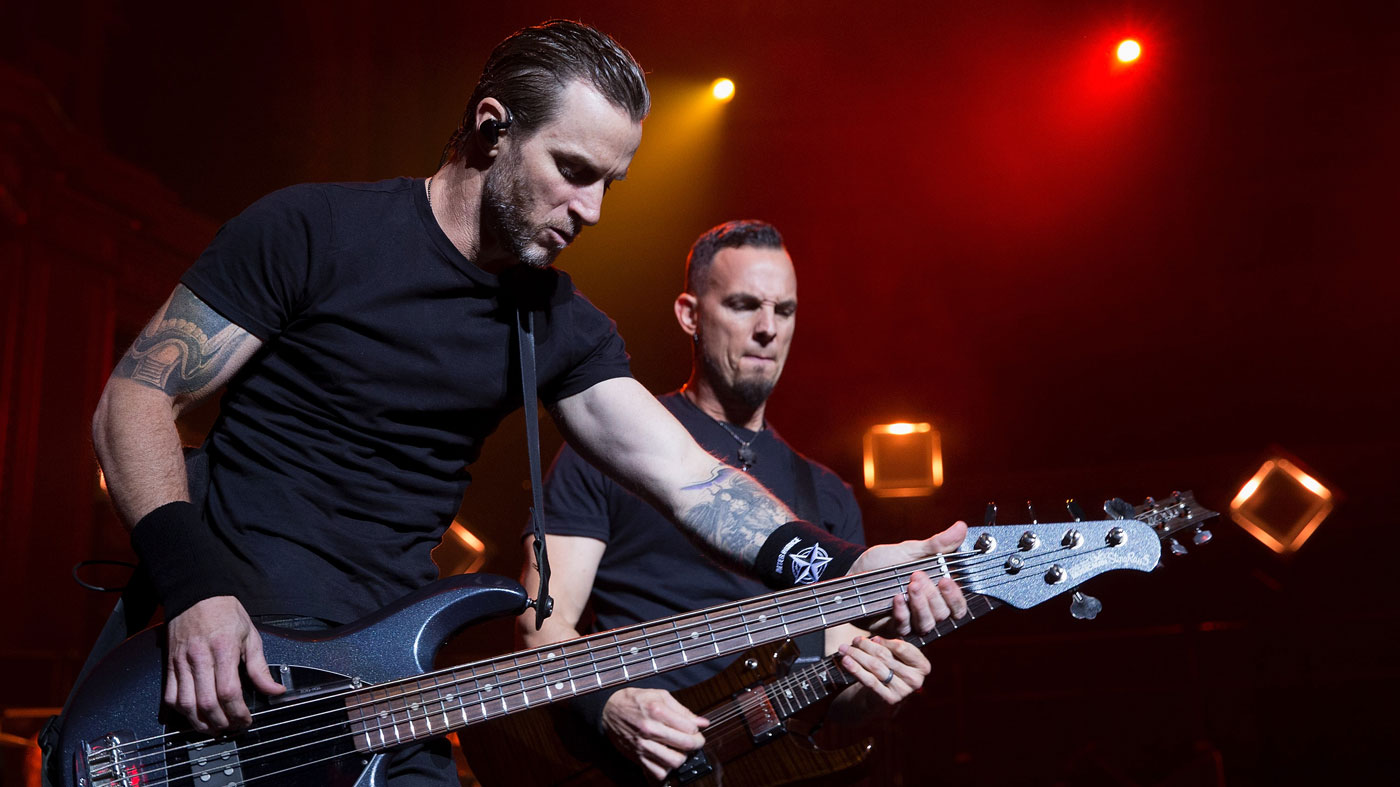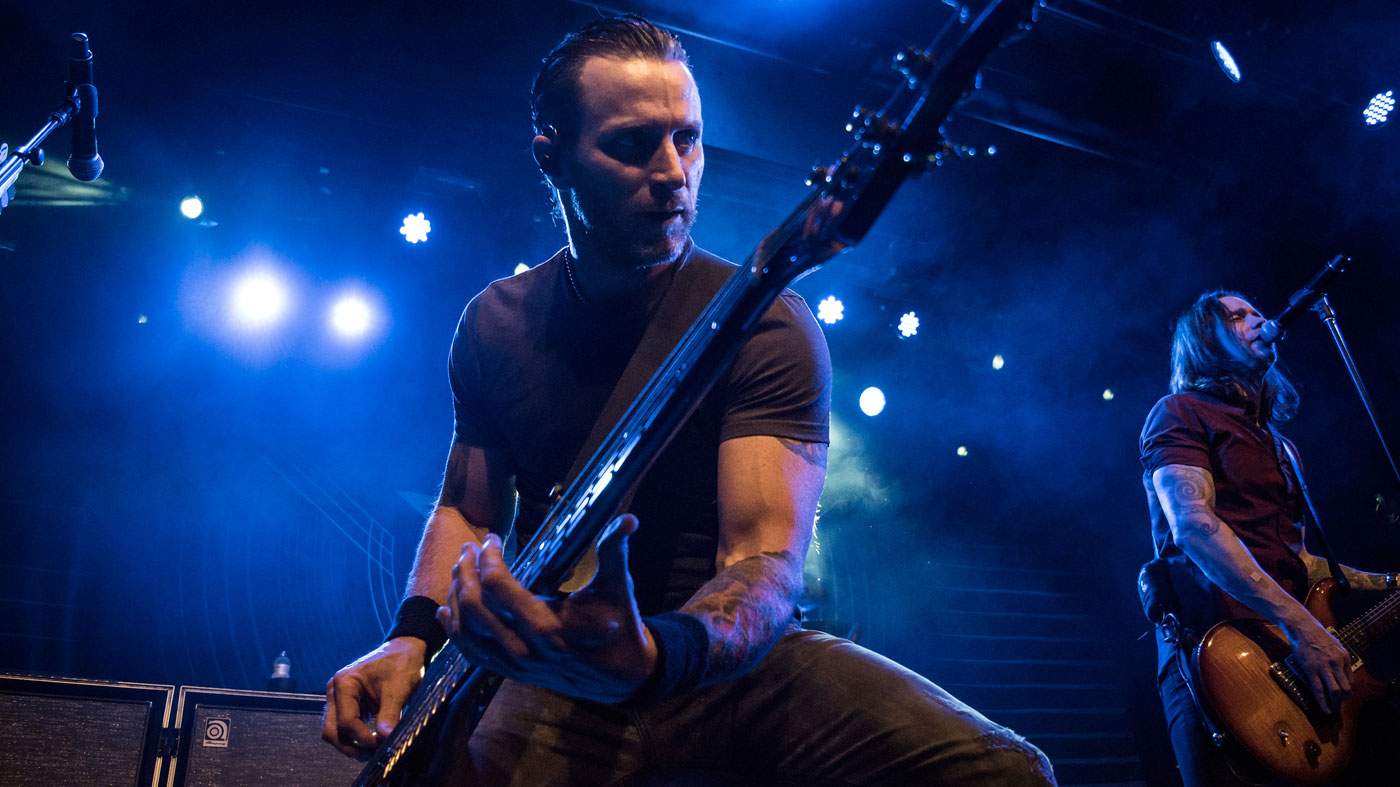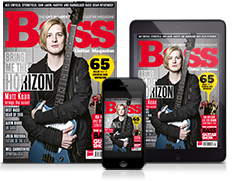Alter Bridge's Brian Marshall: “Sometimes, if I’m close enough to the kick drum, it’s like the bass plays itself”
The bassman on rigs, clicks and playing as a unit

Commemorating one of the biggest nights of their career to date, American stadium-rockers Alter Bridge unleash a new live album. Bassist Brian Marshall meets Alison Richter for the low-end lowdown.
Clichéd as it may sound, the first thing one hears on Alter Bridge’s Live At The 02 Arena + Rarities - a recording of their November 24, 2016 performance at London’s biggest live venue - is the proverbial roar of the crowd. It’s deafening. It’s almost enough to drown out the band, and that’s saying something, because Alter Bridge - vocalist/ guitarist Myles Kennedy, guitarist Mark Tremonti, bassist Brian Marshall, and drummer Scott ‘Flip’ Phillips - are a loud band.
Live At The O2 Arena is very much a ‘what you hear is what you get’ recording - nothing was added or overdubbed, says Marshall. “We brought out [mixer and mastering engineer] Brian Sperber for that whole UK run, and the cool thing about it is there’s nothing that we added in post-production, so what you hear is actually what we’re playing live on that stage. We pride ourselves on that and the fact that we don’t use any backing tracks or backing vocals.”
He adds: “We do use loops for beginnings and endings of songs, but they’re strictly for transitions and guitar changes to keep the flow of the show going. We don’t use all those things that some other bands tend to use, and there’s a certain amount of pride that goes with being able to do that. We started getting the mixes from Brian a couple of weeks after the tour and it was pretty much spot on. We changed some levels, but there was no overdubbing or changing what we played.”

Passively active
For years, Marshall relied on Music Man basses in the studio and Sadowsky basses live. “That has a lot to do with me being so stubborn about being a passive bass player,” he says. “I always wanted to perform passive, because I felt like there’s too much gain going on with the active pickups. Even though the Sadowsky basses have the active/passive option, I always steered away from it as a passive player.”
My sweet spot is in front of the kick drum, in front of one of my 8x10s. It’s where I can feel all the resonance of the stage
Last summer, Ernie Ball sent him a Stingray, though - and thus began his conversion. “I started playing their neck-through SR5 basses and was blown away,” he says. “I couldn’t go from a passive bass to an active bass on the same stage, because it’s such a drastic difference in tone and volume, but we went out with Disturbed and it was such a difference. I could hear myself better in my in-ears, the clarity was better, the front-of-house guy said it was amazing, my friends and peers were hearing bass tones, so finally I was excited about my live situation.”
Because Alter Bridge spend so much time on the road, both in the US and abroad, Marshall relies on two rigs. He goes wireless through a Shure system and runs a Tech 21 Sansamp that “dirties up the tone a little bit. From there, I’m going into an Ampeg SVT VR rig with two heads and two 8x10s. That’s the rig I use for the States. In Europe, I’ve been playing Ashdown for years.
Want all the hottest music and gear news, reviews, deals, features and more, direct to your inbox? Sign up here.
“I recently started using an ABM 900, and again two 8x10s, their Classic Series speakers. They’re constantly shipping these rigs around, so I don’t have two of the same. They’re both completely awesome. They each have a little bit of a different vibe to them, but I love them both. The Ashdown has more bottom end and more round feeling, whereas the Ampeg rig seems to cut a little better for me in the midrange.
“So normally it’s two 8x10s, and if it’s a bigger show, two 8x10s and two 15s that sit in the middle. On the floor I have a tuner and a Dunlop distortion pedal, and I kick that on in different parts of the song. It’s usually sitting back right about where the drum riser meets the first cabinet. I choose where I want to hit that. If I want to fill the room with a certain part of the song, I throw it on for a minute. I try not to overuse it because I’ve got that Sansamp going 24/7 back there.
“I tend to float around the stage a lot, but my sweet spot is in front of the kick drum, in front of one of my 8x10s. It’s where I can feel all the resonance of the stage and the low end. Sometimes, if I’m close enough to the kick drum and where I want to be, the sustain happens on its own. It’s like the bass plays itself. I find that sweet spot on the stage and it’s my little bubble. It’s where I can go to be safe!”
In the pocket
Logging in thousands of miles, performances, and hours of studio time, the members of Alter Bridge are locked in tightly as a unit. Still, says Marshall, it’s critical that he and Phillips stay in that pocket while balancing between two very different guitar players.
“Myles is theory-oriented and plays very soft but fast, while Mark digs in; he’s super-fast and more aggressive,” he says. “Trying to find a balance between those two, and with two totally different-sounding rigs - it has taken years to get it right, to where the bass sits in the mix and doesn’t step on the other instruments. It’s taken a lot of work to get it there.”
“The bass is a unique instrument in the sense that sometimes I’m playing with the rhythm guitar and the way that it’s moving, sometimes I’m cuing off the vocal, and at all times I’m locked in with the drums,” he says.
It’s that reliability that's key as a rhythm section. We really can’t afford a train wreck. At all costs, avoid a train wreck!
“I’ve never been a bass player who likes to stay with chord progressions. I like to make the bass as creative as I can. I’ve always been a fan of space because that gives me more room to move, and that’s few and far between with Alter Bridge, so I try to take as much advantage of it as I can! I tell Mark, ‘Music is not a race to the finish, man’.”
Marshall and Phillips use a click during a portion of each show in order to stay on track between the two guitarists, and particularly to keep up with Tremonti.
“We’ve all played together for years, so at this point there’s a certain comfort level,” he says. “I know what they’re going to do, but sometimes they keep me guessing and I do the same with them. For the most part, the guitars will be doing totally different things, and that’s when it’s important for me and Flip to lock in.
“We use a click maybe 60 percent of the time. Some of the songs feel better off the click, like Blackbird - we’d never play that with a click and every night it’s spoton. But Metalingus - if there wasn’t a click on that song, we’d be completely screwed! I have that click blaring. It’s got to lock in because the passages are moving so fast.”
“Mark is never on a click; he’s the only one not on in-ears. He strictly relies on his wedges, so he pushes and pulls all night. It’s important for me and Flip to have that foundation consistently, so that we can reel him back in, especially at the beginning of the show. The anticipation about getting out there - he gets real aggressive and that’s when I tend to lay back more.
“It’s kind of a fine balance because I know he’s going to go out there with the aggression and he’s going to be rushing, so when I walk on that stage I want to make sure that I’m in the pocket, I’m in my sweet spot. That initial rush to get out there and get the song done, it leads him, and then the show really starts flowing.
“It’s important for us as a rhythm section to always have that foundation, lock in, and be reliable, so that if someone, God forbid, gets lost in the song, they can always look back at us and say ‘Here it is, here’s the one, here’s where you’ve got to come in - boom ’. It’s that reliability. We really can’t afford a train wreck. At all costs, avoid a train wreck!”
Live At The O2 Arena + Rarities is out now on Napalm.


